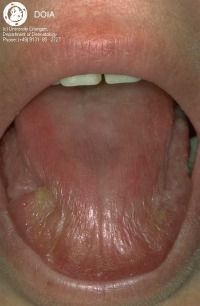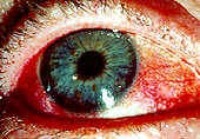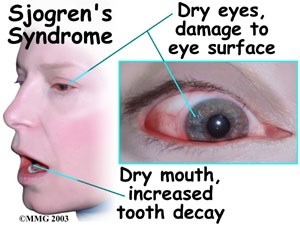|
Sjogrens Syndrome
Are your eyes extremely dry? Do you have a dry mouth as well? Do you have any body complaints like dry skin, skin rashes, or weakness in joints or muscles? You may have Sjogrens syndrome. What is Sjogrens syndrome?
Sjogrens syndrome is a chronic autoimmune disease. Autoimmune diseases are caused by the action of antibodies produced against your own body’s normally occurring substances. In the case of Sjogren’s syndrome, there is an accumulation of lymphocytes (white blood cells) and plasma cells in your exocrine glands resulting in inflammation and disruption of normal glandular activity. The chronic inflammation ultimately renders the glands dysfunctional. Exocrine glands are those that release their secretions to the body’s cavities, organs, or surface through a duct. Examples of this type of glands include: It is no surprise that Sjogren’s syndrome is characterized by dryness symptoms. What exactly causes Sjogren’s syndrome is not known, but researchers speculate that the condition results from a combination of genetic and environmental factors. Several different genes may be involved in different racial and ethnic groups, and a trigger factor such as a viral or bacterial infection may serve to activate the specific gene. The immune reaction that is initiated in response to an infection is somehow altered and redirected toward the exocrine glands. Sjogren’s syndrome is the second most common autoimmune disease affecting mainly middle-aged women. The female-to-male ratio of occurrence is approximately 10 to 1. Sjogren’s syndrome appears clinically to come in two varieties:
What are signs and symptoms of Sjogrens syndrome?
Symptoms that may be described include: 

How is Sjogrens syndrome diagnosed?
Diagnosis is going to begin with you sharing with your general or eye doctor your symptoms of dryness. Your symptoms should make your doctor suspicious of Sjogren’s syndrome, especially if you are an older woman with Dry Eyes and other concurrent dryness symptoms. If your doctor suspects Sjogren’s syndrome, you will be instructed to undergo a full rheumatologic examination. You will get a referral to a dentist or oral surgeon skilled in managing this condition. You may have an increased risk of tooth loss, gingival recession and adult periodontitis when compared to age and race-matched healthy controls. Laboratory testing that may be done include: Biopsies of the salivary or tear glands are very helpful in identifying lymphocytic accumulation. Despite these resources, if you have Primary Sjogren’s syndrome, there is a lack of a simple diagnostic test for the condition. None of the antibodies mentioned above are specific for Sjogren’s syndrome. In terms of a salivary gland biopsy, a major drawback of this procedure is that it only measures severity of inflammation. Because of these diagnostic difficulties, studies are investigating the potential use of salivary electrophoresis in the diagnosis of primary Sjogren’s syndrome. The electrophoresis of saliva from patients with Sjogren’s syndrome can be a simple and rapid method, requiring only a minute amount of saliva for the analysis. Further studies have to be done. How is Sjogrens syndrome treated or managed?
The treatment of Sjogrens syndrome is going to primarily be aimed at alleviating the symptoms such that you will be able to continue to engage in normal day-to-day activities. When you see your eye doctor, his or her first priority will be to treat your Dry Eyes. Your general doctor may prescribe medications to help you with your dry mouth. Sipping fluids (preferably water) throughout the day may be helpful and lozenges can help stimulate saliva production. Use caution in using sugared beverages and candy, as you may be prone to rapid tooth decay. As you can see, Sjogren’s syndrome can affect many parts of your body beyond your eyes and mouth. You may have to go to a variety of medical specialists. Go regularly to your eye doctor, dentist and rheumatologist. |





